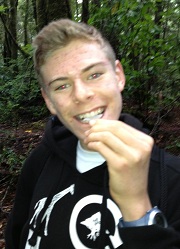They pop up in our grass, on our trees, in the garden and sometimes as decorations. Mushrooms, the fruiting body of fungi, can be magical, decorative and a sign of decay. Few places have as many varieties as the north coast of California. To satisfy my son’s curiosity about eating veggies you find in the wild, we went on a little nature/mushroom foraging walk.
Our tour guide was Adrienne Long from Mendocino-Fort Bragg area.
She has been leading tours and gathering her own mushrooms to eat for years. Even though she had her trusty mushroom identifying book with her, she pretty much knew the variety from 10 paces away. One of the more challenging aspects of identifying mushrooms is the climatic conditions they grew in and the age of the fruiting body.
We saw the same type of mushroom in different stages from newly sprouted to slimy and dissolving apart. With over 3,000 varieties growing in the area there are numerous little types the locals just classify as LBMs, little brown mushrooms. Adrienne would point out the patterns that the mushrooms were growing in, along specific types of hardwoods, around different types of forest floor clutter or up dead trees.
The colors were pretty amazing and once you started looking, the mushrooms were all over the place. Before you know it you are climbing over trees, blazing new trails or looking up trees to find different mushrooms. You quickly realize that if there is anything dead in the forest, it probably has some sort of fungus attached to it.
Most of the mushrooms or fruiting bodies of fungus you find are not necessarily edible. Less than 10% of what we saw you would want to take home and cook up. The other 90% actually provided a visual treat for the eyes. All of these mushrooms were found within 3 acre area.
The redwood forest by itself doesn’t support a tremendous variety of
mushrooms. Redwood trees, because of the tannin in their bark and wood are very good at resisting the intrusion and fungus when the tree is either dead or alive. Consequently, a large number of mushrooms were found feasting on the dead forest litter and trees that had been introduced into the forest like hemlocks.
We also learned that the areas a person can forage and collect mushrooms in California are severely limited outside of private property. Part of the issue is mushroom gathers scouring the trails and hill sides and selling their bounty to local markets. There are couple locations where you can pick up to a maximum amount, but many of the federal, state parks and forest have various guidelines for collection.
At the end of our two hour hike, Adrienne handed us a couple of wax paper bags full of
mushrooms, primarily hedgehogs and winter chanterelles, to take home. Not
since getting his first cell phone was my son so excited. He had been sampling mushrooms out in the wild, including Redwood sorrel, now he got to cook some up back at the house. With a little bit of butter and a hint of rosemary herb he threw in, the mushrooms had a creamy taste and were nice and firm.
While I won’t be collecting wild mushrooms anytime soon to cook up at home, it was a lot of fun to have a trusted and trained guide help us collect mushrooms as a side dish to a nice evening meal. Adrienne Long is available for small group mushroom foraging nature hikes in Mendocino. You can reach her at 707-964-2883 or email at biobotlover@yahoo.com
Shelf, conk mushrooms usually growing on tree trunks and branches Bracket fungus. The poisonous and psychotropic mushrooms Amanita muscaria. Coral mushroom in a variety of colors Clavarioid Fungi. Witches butter Tremella mesenterica. Hedgehog mushrooms because their spore bearing parts look like little teeth instead of gills or pores Hydnum repandum. Winter chanterelle that is the cousin of the more popular mushroom Chanterelle. Jelly hedgehog mushrooms Pseudohydnum gelatinosum. Ceramicus colorifinia is the species and genus for the colorful ceramic mushrooms you can buy in Mendocino and Fort Bragg and stick in your garden at home.
